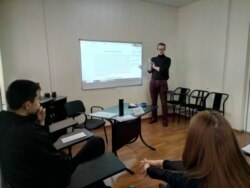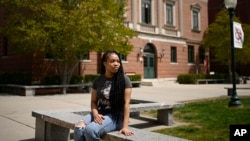Student Union
- By Carl Liles
Fulbright Shelters in Bishkek as COVID-19 Empties Streets
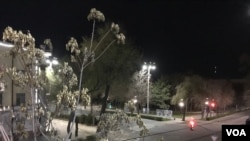
An uncomfortable silence has settled on the normally busy boulevards and avenues of Bishkek, Kyrgyzstan.
Its high rises, trendy shops and other newcomers — ushered in by the sudden shift to market economics in the early 1990s — sit among slabs of gray concrete and rare czarist architecture that came before.
But, COVID-19 and the emergency state measures enacted by authorities to prevent any further spread of the disease have left these areas and other open spaces, like parks and cafés, absent of city residents. The vibe of springtime Bishkek is uncharacteristically different this year.
Local media and rumor keep apace of one another as the general public receives new information and learns of regulations that will shape everyone’s lives for the next several months. Parallel real-time developments in other countries leave those of us speculating as to how things will play out.
But for now, my time as a Fulbright scholar has come to an abrupt close. And I wait in isolation until COVID-19 is controlled.
Fulbright grant to teach
I came to Kyrgyzstan in August 2017 after finishing my bachelor’s degree at the University of Virginia, excited to begin a new life as a Peace Corps volunteer for two years. Toward the end of my service, I was offered a Fulbright grant to teach English classes at a private university in the capital of Bishkek. I started in October 2019.
On March 13, our WhatsApp group of Central Asian Fulbright English Teaching Assistants (ETAs) began to exchange a flurry of messages. The State Department was shuttering the Fulbright Program for the rest of the year.
What were the embassies saying? Who was staying? Who was leaving? Personal messages to friends and other loved ones went back and forth as we discussed our options and tried to come to grips with the potential futures we faced.
For most of us it was a difficult choice. We had committed to 10 months in our host countries and were adjusting to our new assignments. Routines were developed; social circles were formed. There were connections and revelations lying ahead for us as Fulbright ETAs.
For many, this abruptness was an unexpected intruder. News that we could leave without repercussion from the Fulbright program, followed by the order to evacuate, came with a flood of heavy emotions for all.
In the ensuing hours and days after we were told to leave Kyrgyzstan, it became obvious that a smooth return to the United States could be challenging. Rumors swirled about flight availability, cancellations and quarantines. Stories of being trapped in airports for more than a week came from WhatsApp and other social media platforms.
“In these unprecedented circumstances, we also recognize that due to conditions in specific countries, including the closing of borders and air space, the lack of available flights, or other safety considerations, not all U.S. Fulbright participants will be able to depart for the United States at this time,” the Fulbright program announced.
The risks of contracting COVID-19 in transit, and the sheer uncertainty of becoming a temporary resident in an airport terminal for an indefinite period, painted a somewhat bleak picture for returning stateside.
Thankfully, the State Department informed us that without safe and certain options for returning to the States, we could remain in our respective counties as private citizens — that is, if we were prepared to stay put for an undetermined time.
Waiting it out
Personally, I was immensely relieved that we were given the option to remain abroad. I believe I am in a better position to self-isolate and avoid COVID-19 — as well as not infect my loved ones with it — here in Kyrgyzstan than in the States.
Moreover, in my heart I felt that I wasn’t ready to go home. For me and other Fulbrights, returning to the States with no plans and few opportunities was unthinkable only three weeks ago. We had hoped to experience so much more while abroad, yet for reasons beyond our control, that opportunity vanished over the course of a few days.
Because of the internet, self-isolation in the coming months will be (hopefully) bearable. Communicating with friends and family across the globe, and consuming a near endless amount of media at the click of a mouse, make life a little less boring when social interaction is limited.
There are plenty of grocery stores and pharmacies near my apartment, which has a pleasant street view from all three of its rooms. Over time, these advantages may not prove to be as sustainable as I had hoped. But for the moment, I am thankful to have them.
The Fulbright ETA program is a truly exceptional way to teach and learn outside the U.S. We were each afforded the opportunity to live and integrate into cultures and countries that we otherwise would not have explored.
The Fulbright Program develops a more globally conscious population in the U.S. and abroad. We expanded our minds through cultural exchange, as well as those of our peers and counterparts in our host countries. For this, I and my fellow Fulbright 2019-2020 cohort will always be grateful.
See all News Updates of the Day
- By VOA News
Amid internship pressure, international students should focus on self-care

That’s the argument of Edhita Singhal, an international student from India studying at the University of Southern California.
Despite the fear of not finding a good internship, it’s important to relax and take care of yourself, she writes in her biweekly column for campus newspaper The Daily Trojan. (April 2024)
- By Tina Trinh
Columbia students on edge as police presence remains on campus after raid to clear protesters
Police remain on Columbia University’s campus, even after clearing out student protesters and their encampment. But questions remain about how the university and the students move forward. Tina Trinh reports from New York.
Columbia University student journalists had an up-close view for days of drama
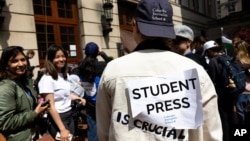
Student journalists on the Columbia University campus knew what was coming long before police with riot shields arrived to begin arresting the pro-Palestinian protesters.
They had watched the situation spiral as the protesters stood their ground, refusing to abandon Hamilton Hall and using a pulley system to bring supplies into the building they had occupied.
The reporters, working for university and online U.S. and international publications, suspected negotiations with administrators were going nowhere when the protesters began donning COVID-era masks to hide their identities. Some began sleeping on the floor in journalism classrooms or offices out of fear of missing something.
But when a journalism professor began writing the phone number to call if they were arrested in permanent marker on their arms, that was the moment it became clear: They were capturing history.
The police operation Tuesday night that cleared out Hamilton Hall capped two weeks of drama over the protests at Columbia, which student journalists at the Ivy League school lived through as they were covering it.
Other media were being kept off campus, so these reporters were the only ones who could capture what was happening.
"I just woke up and I was like, I'm going to go and take some pictures," said Seyma Bayram, a Columbia journalism fellow focused on creating a longform investigative podcast unrelated to the protests.
The encampments were a visual feast. There were musical performances, students reading and helping each other write papers for their classes. She wanted to document it all.
By Monday, students were facing suspension if they didn't leave. Crowds marched around the encampment chanting. Students were given written notices from the administration, warning them to go. They ripped them up, dumped them in trash bins. Rumors were flying.
That night, Bayram was unwilling to go home, sleeping on her office floor.
"How," she wondered, "are they going to remove the students. They're not leaving."
By Tuesday, she was exhausted. The student reporters charged their cameras and other gear and waited.
Many protesters were starting to leave, recalled Shayeza Walid, a graduate journalism student at Columbia, who covered the arrests for the news website Al-Monitor.
The sun was setting as they held hands and chanted, knowing they faced academic repercussions by remaining. Many had given up covering their faces by now, Walid said.
To her, the chants sounded like a hymn and she saw the protesters, some clad in Palestinian keffiyehs, crying. She doubts she will ever forget it.
"It felt so both inspirational and devastating because these were the kids who were willing to get arrested," she recalled.
And then police started assembling outside, setting up barricades. Even on campus, Bayram could tell by the photos posted on social media that police action was imminent. And then the police were there.
"I don't know, it was just like all of a sudden there were just like police, ... riot gear everywhere," Bayram said.
The student journalists were walking backward, filming as they went, Bayram said.
She was pushed off campus. Police buses and officers were everywhere. Around her, people were being arrested.
"Those of us who are pushed out, like student reporters and faculty, I think we were just all horrified that no press was present outside of, or inside of, Hamilton Hall," Bayram said.
Walid recalled that the reporters paired up for safety. Her partner, an international student, had never seen so many police in one place. "And frankly, I hadn't either," Walid said.
She said the police also seemed shocked when they came into campus and saw how few students were left. "It was very evidently disproportionate from where we were standing," she said.
Before the arrests, protesters inside the campus used a megaphone to lead those protesting outside in chants, recalled Cecilia Blotto, a graduate journalism student, who has been publishing photos and video to Uptown Radio, a project of the university's journalism program.
"Columbia, you are a liar," she recalled them chanting, along with "Disclose, divest! We will not stop, we will not rest."
Then Blotto saw police buses pull up, officers exiting with shields and zip ties. Then they played a recording saying that if the protesters didn't disperse they would be arrested.
"People were like being dragged out on the street, with like four cops holding a leg and an arm each. I saw some really, like, striking images of people, like, yelling shame at the cops, while they were dragging out students," Blotto said. She tried to film it all.
Emily Byrski, a graduate student who had a phone number written on her arm in case she was arrested, said the students weren't totally unprepared. There had been a training session.
Still, she said, there had been so many false alerts.
"It's like the boy who cried wolf. Like, there were two or three nights here where we were told, there was a rumor going around that the NYPD was coming, please come to campus," she recalled.
Byrski had knee surgery earlier in the year, so was unable to run as police descended. She limped along with her buddy.
"So we're sort of seeing this all happen from inside and trying to document it as the NYPD is grabbing people, like shoving them to the ground. It was pretty horrifying to see, like, right a foot away from me," Byrski said.
She said she has seen professors cry over the last week. She is pondering it all, uncertain what to make of it.
"I'm just sort of in shock," Byrski said. "I think we all kind of were in shock."
Botched US student aid application form rollout leaves many in limbo
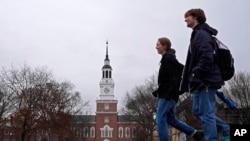
The last thing standing between Ashnaelle Bijoux and her college dream is the FAFSA form — a financial aid application that's supposed to help students go to college but is blocking her instead. She has tried to submit it over and over. Every time, it fails to go through.
"I feel overwhelmed and stressed out," said Bijoux, 19. She came close to tears the last time she tried the form. "I feel like I'm being held back."
Normally a time of celebration for high school seniors, this spring has been marred by the federal government's botched rollout of the new FAFSA application. By May 1, students usually know where they're headed to college in the fall. This year, most still haven't received financial aid offers. Three months before the start of fall classes, many don't know where they're going to college, or how they're going to pay for it.
"We're asking them to make probably one of the biggest financial decisions — and decisions that will have the biggest implications on their lives going forward — without all of the information," said Justin Draeger, president and CEO of the National Association of Student Financial Aid Administrators.
FAFSA, or Free Application for Federal Student Aid, went through a massive overhaul that was supposed to make it simpler and shorter. But a series of blunders by the Education Department made it harder than ever, delaying college decisions by months and raising fears that hundreds of thousands of students will forgo college entirely.
Across the United States, the number of students who have successfully submitted the FAFSA is down 29% from this time last year, and it's even worse at schools with more low-income students, according to the National College Attainment Network.
The group's CEO, Kim Cook, warned members of Congress this month about a potentially "catastrophic" drop in college enrollments that would make the decreases of the pandemic seem mild.
For Bijoux of Norwich, Connecticut, the FAFSA problems threaten to undermine the promise of higher education.
To her, college is a chance to seize the opportunities that weren't available to her mother, who immigrated from Haiti to the U.S. as an adult. Bijoux hopes to become a therapist and set a positive example for her three younger brothers.
If her FAFSA goes through, she should be eligible for enough financial aid to help with the $13,000-a-year tuition at Southern Connecticut State University. If not, she might go to a local community college, but even that would require loans if she can't complete the FAFSA.
"That's why it hurts, because it's like you work so hard to go somewhere and do something and make something of yourself," Bijoux said. "I thought I would start at a four-year (college) and then work hard continuously, like I've been doing basically my whole life. But that's not the case."
The updated FAFSA form has one section filled out by students and another by their parents. But when Bijoux finishes her part, nothing shows up on her mom's online account. She keeps trying, but nothing seems to change.
Similar problems have been reported across the country, along with numerous other bugs that the Education Department has scrambled to fix. Families who call for customer service have faced long wait times or say the call center hung up on them.
It "drains all the momentum" from families working to send their children to college, especially those navigating the process for the first time, said Anne Zinn, a counselor at Norwich Free Academy, where Bijoux goes to school.
"I can only say so many times, 'Just be patient, just be patient,' before they throw their hands up and they're like, 'Why am I doing this? I'm just going to go get a job,'" she said.
The rollout has attracted bipartisan criticism in Congress, and it's being investigated at the request of Republicans. Last week, Richard Cordray, the federal student loan chief who oversaw the FAFSA update, announced he's stepping down at the end of June.
For colleges, too, the delays pose a major threat.
Enrollment decreases like those being projected now could put many small colleges out of business or necessitate deep cuts in staff. Some colleges are pushing for emergency relief just to stay afloat, said Angel Pérez, CEO of the National Association for College Admission Counseling.
"If they don't get checks from the federal government to basically get them through next year, they will not survive," Pérez said.
FAFSA has been the linchpin of student financial aid for decades. It's used to determine eligibility for the federal Pell grant, a scholarship for low-income students, and it's required to receive federal student loans. Colleges and states also use FAFSA to distribute their own scholarships.
FAFSA had long been maligned for being tedious, difficult and intimidating to families without college experience. Congress passed legislation in 2020 meant to simplify the form. The Education Department was ordered to reduce the number of questions from more than 100 to about 40 and change the formula to expand aid to more students.
Problems started piling up as soon as the new form went online in December, already months overdue.
The first applications were incorrectly processed using an outdated calculation for inflation. Later, a federal contractor miscalculated a different formula on more than 200,000 applications. Each mistake added to delays, leaving students waiting longer to hear anything about financial aid.
Even more worrisome is a misstep that blocked students from finishing the form if they have a parent without a Social Security number. Advocates say the system locked out hundreds of thousands of students who are U.S. citizens or permanent residents but whose parents are not.
The Education Department on Tuesday said it's giving those parents a new way to enter their tax information manually. But as recently as this week, some students said they were still blocked from submitting the form.
Federal education officials say they're addressing lingering bugs but making progress. More than 8 million student applications have now been processed and sent to colleges, the agency said, and new applications are being processed within three days.
Still, the wait is far from over. It usually takes weeks for schools to prepare financial aid offers. Some colleges have extended decision deadlines to give students more time to weigh their options. But some stuck to May 1, forcing students to choose a college — and make a nonrefundable payment to hold their spot — without knowing all their scholarship options.
In Baltimore, Camryn Carter is waiting to find out if he'll get a full ride to the University of Maryland or face tens of thousands of dollars in student loans.
A top student and captain of his baseball and wrestling teams, Carter sees college as a step up in life. He thinks back to the times in the grocery store line when he had to put items back on the shelf because his mom couldn't afford the bill. A college degree would give him the stability he didn't always have, the 18-year-old said.
But when he looks at tuition, it's intimidating. Along with Maryland, he's also considering McDaniel College, a private school in Maryland. If he enrolls there, he expects to borrow almost $30,000 a year.
"I try to make the best decisions now so I can have a good future," he said. "I'm a little nervous that things won't work out. But I'm faithful."
- By VOA News
Florida program helps migrant students tutor younger children
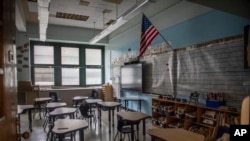
The 40-year-old initiative pairs migrant students in high school with elementary school children. High schools earn college scholarship money for their work. (April 2024)




